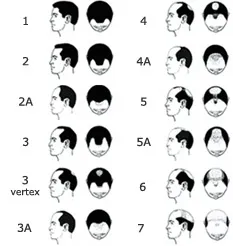Causes of Hair Loss
Hair loss is an unpleasant fact for millions of people in the United States. Varying degrees of baldness can be caused by heredity, certain medications or underlying medical conditions. Men, women and even children can experience loss of hair. Some people take losing their hair as a fact of life as they grow older, while others suffer from anxiety and depression.
Androgenetic Alopecia
At least 90% of hair loss seen in both men and women is caused by Androgenetic Alopecia, or common genetic hair loss. Androgenetic Alopecia is a progressive condition affecting 40 million men and 20 million women in the U.S. Hereditary hair loss can begin as early as the teenage years and affects 30% of both sexes by age 30 and 50% by age 50.
In men and women with Androgenic Alopecia, or genetic hair loss, hair follicles are sensitive to the hormone dihydrotestosterone (DHT), a byproduct of testosterone. At some point, hormonal changes result in Follicle Miniaturization, a process of follicle skrinkage which causes terminal hairs on the scalp to become fine vellus hairs with a shorter growth cycle. Eventually, this "peach fuzz" may disappear entirely to produce completely bald spots in men or a significant thinning in women.


Androgenetic Alopecia in Men
Androgenetic Alopecia is called Male Pattern Baldness in men. Male pattern baldness usually starts with a receding hairline and a thinning of the hair on the top of the head. Hair loss in men can range from partial loss to a bald crown with a only a horseshoe-shaped area of remaining hair at the sides and back of the head.

The Hamilton-Norwood Scale, shown at right, is a tool used to assess the progression of male pattern baldness. Type I men have little or no hair loss, while Type VII individuals have complete hair loss along the front and crown. This tool is helpful as a guide to determine the degree of baldness and the methods of hair restoration that may be the most effective.
For men with Androgenetic Alopecia, hair transplants performed at Alabama Hair Transplant in Birmingham, Alabama are a proven way to fill balding areas with new, growing hair using the latest hair restoration techniques.
Androgenetic Alopecia in Women
Androgenetic Alopecia, called Female Pattern Baldness in women, rarely results in complete baldness but usually occurs as a diffuse, overall thinning. Hair loss in women can occur at any time after puberty, but often appears during menopause because of changing hormone levels.

The Ludwig Classification, shown at right, is used to determine the degree of hair loss in women. Grade I hair loss under the Ludwig scale is considered to be mild, while Grade II is moderate hair loss and Grade III is extensive hair loss.
For women with Androgenetic Alopecia, hair transplants performed by the hair restoration specialists at Alabama Hair Transplant in Birmingham, Alabama are proven to be effective in filling in areas of hair loss using the latest techniques which maximize new hair growth, minimize scarring and produce natural-looking results.

Other Causes of Hair Loss
Even people who are not genetically susceptible to losing their hair can experience hair loss from other causes:
- Telogen Effluvium occurs when sudden or severe stress causes hair follicles to stop growing and prematurely enter the Telogen Phase, or resting phase, prior to being shed. Hair loss is usually temporary, but in some cases can continue until the underlying cause is resolved.
- Alopecia Areata is a condition where the body's immune system attacks its own hair. Patients commonly see a sudden loss of hair in one or more circular or oval patches, but can experience widespread patchy loss. This condition usually resolves spontaneously. Recovery can be speeded by steroid injections.
- Anagen Effluvium is a rapid shedding of hair caused by chemotherapy and certain other medications. This condition usually improves within 6 months of stopping the medication.
- Traction Alopecia is caused by repetitive, continuous pulling of hairs by certain hairstyles. Changing the hairstyle will usually solve the problem, but permanent hair loss may result if the style is not changed.
- Trichotillomania is a mental condition where people have an irressistable urge to pull or twist their hair. Patchy bald spots can result when hair is pulled from the scalp.
- Hormonal changes — such as those experienced during pregnancy, after childbirth, during menopause or in people with imbalanced thyroid levels — can cause temporary hair loss.
- Poor nutrition can cause hair loss for people with an inadequate supply of protein or iron in their diet or who are poorly nourished in other ways.
- Hair treatments can cause hair shafts to be damaged and break off if chemicals used for dying, bleaching, straightening, etc., are overused or used incorrectly.

